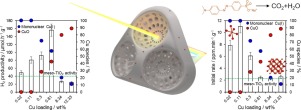Applied Catalysis B: Environment and Energy ( IF 22.1 ) Pub Date : 2018-03-22 , DOI: 10.1016/j.apcatb.2018.03.078 Rima Trofimovaite , Christopher M.A. Parlett , Santosh Kumar , Lucia Frattini , Mark A. Isaacs , Karen Wilson , Luca Olivi , Ben Coulson , Joyashish Debgupta , Richard E. Douthwaite , Adam F. Lee

|
Tailoring the physicochemical properties and hence reactivity of semiconductor photocatalysts in a predictable fashion, remains a challenge to their industrial application. Here we demonstrate the striking promotional effect of incorporating single Cu(I) atoms, on aqueous phase photocatalytic dye degradation and H2 production over surfactant-templated mesoporous TiO2. X-ray absorption spectroscopy reveals that ultra-low concentrations of copper (0.02–0.1 wt%) introduced into the mesoporous TiO2 surface create isolated Cu (I) species which suppress charge recombination, and confer a six-fold photocatalytic promotion of Methyl Orange degradation and four-fold enhancement of H2 evolution. The impact of mesopore structure and photophysical properties on photocatalytic activity is also quantified for the first time: calcination increases mesopore size and nanocrystalline order, and induces an anatase to rutile phase transition that is accompanied by a decrease in the optical band gap, increased charge carrier lifetime, and a concomitant significant activity enhancement.
中文翻译:

单原子Cu(I)促进介孔二氧化钛用于光催化甲基橙的脱污染和H 2的产生
以可预测的方式调整半导体光催化剂的物理化学性质以及因此的反应性仍然是对其工业应用的挑战。在这里,我们证明了在表面活性剂模板的介孔TiO 2上掺入单个Cu(I)原子对水相光催化染料降解和H 2产生的显着促进作用。X射线吸收光谱显示,引入介孔TiO 2表面的超低浓度铜(0.02–0.1 wt%)产生了分离的Cu(I)物种,从而抑制了电荷复合,并赋予了六倍的甲基橙光催化促进作用H 2的降解和四倍增强进化。介孔结构和光物理性质对光催化活性的影响也首次被量化:煅烧增加了介孔尺寸和纳米晶序,并诱导了锐钛矿到金红石相的转变,伴随着光学带隙的减小,载流子的增加寿命,并同时显着增强活动能力。



























 京公网安备 11010802027423号
京公网安备 11010802027423号